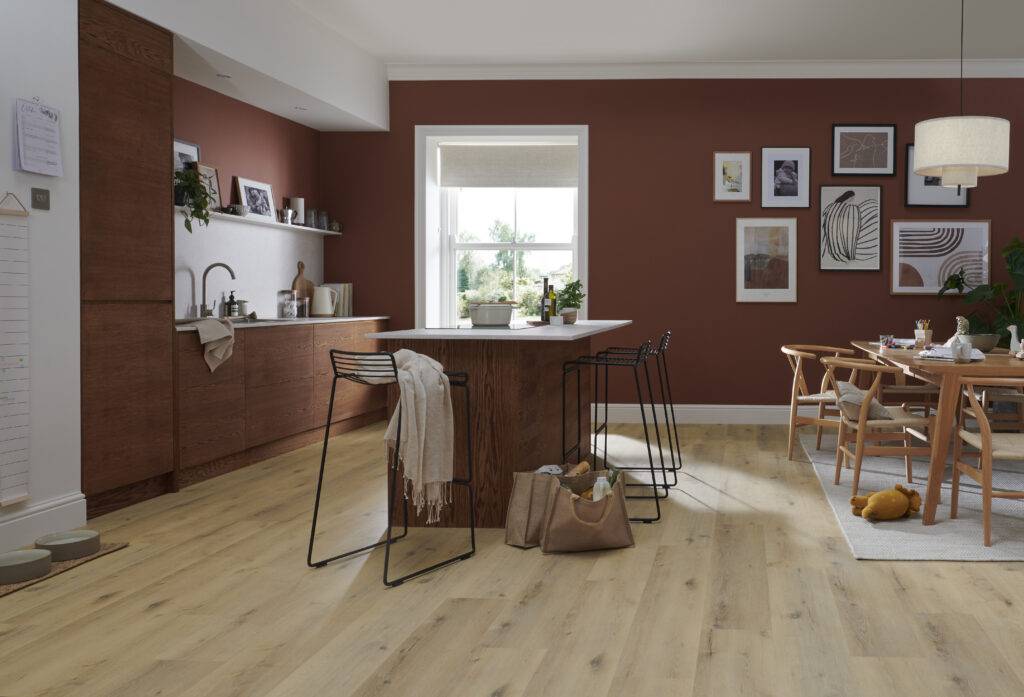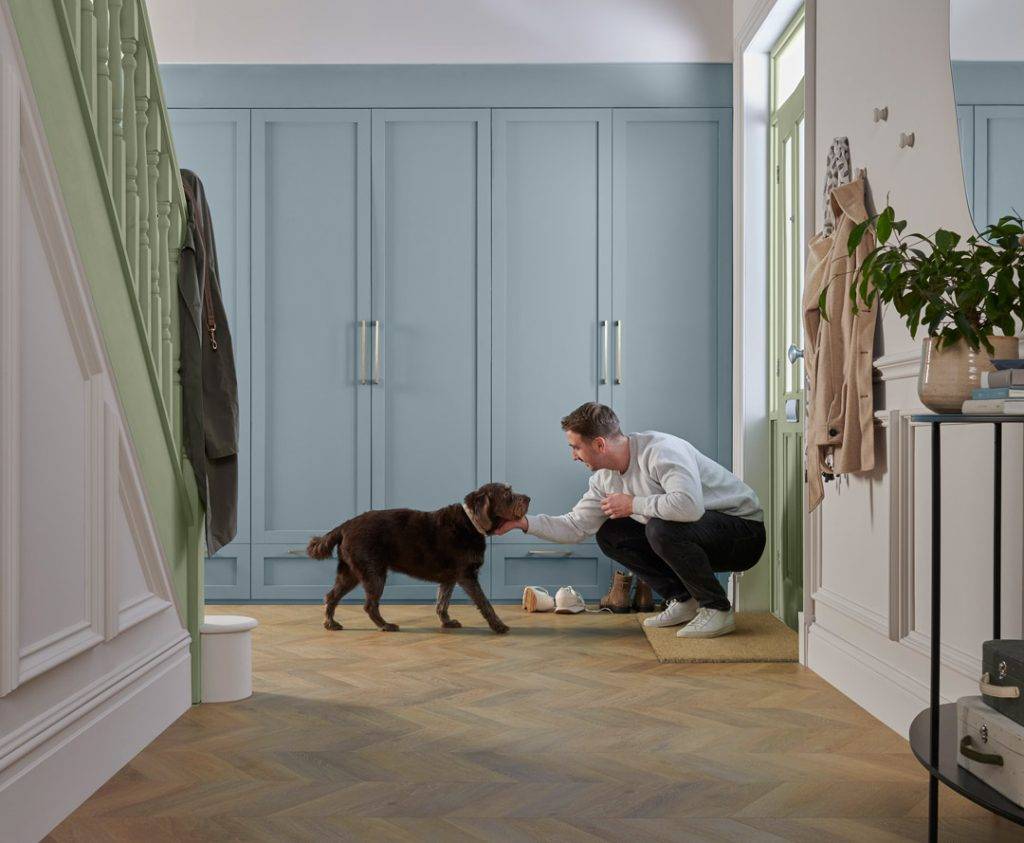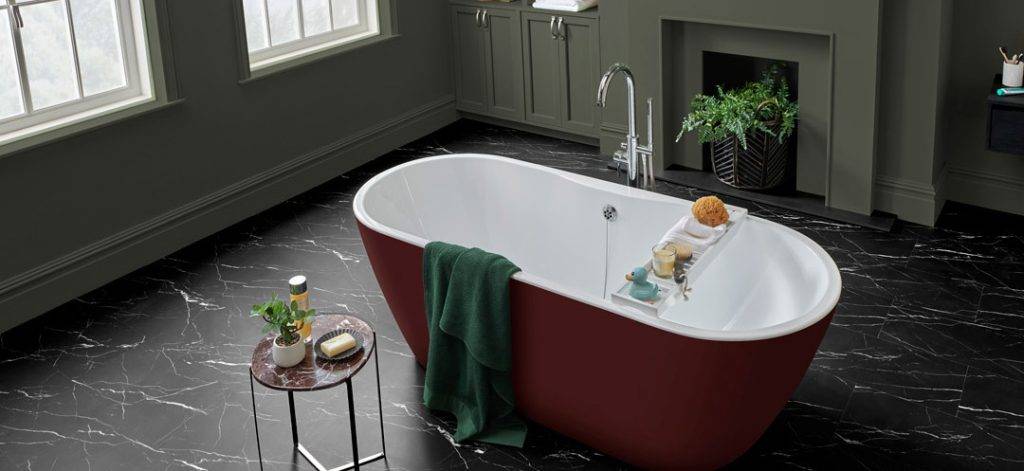Building homes from the floor up
Up to 3 FREE Samples
Building homes from the floor up
Up to 3 FREE Samples
Anyone who has been in the market for a new floor will have no doubt have had LVT show up in their search results. It is, after all, gaining rapid popularity. But what is LVT, what are its benefits, and why is it seen as a worthy rival to both laminate and other types of floor tiles? Read on to find out.
LVT stands for Luxury Vinyl Tiles. LVT flooring is popular for many reasons, but arguably its biggest draw is the wide range of designs available. Able to mimic the look of stone, ceramic and wood, this makes it a highly versatile style option. It is available in both tile and plank form, with a lower-quality cousin – standard sheet vinyl.
Despite its replication of these hard flooring materials, LVT itself is flexible, yet robust in use. On top of this, it gives off a warmer feeling underfoot. These qualities, as well as others, will be expanded upon later in the article.
LVT is made up of several layers, which are bonded and pressed together. Each of these layers has its unique properties which combine to create the experience you will have with LVT.
However, only three of the layers are present in every type of LVT:
| Domestic | Standard Commercial | Heavy Commercial |
|---|---|---|
| 0.30mm Thick Wear Layer | 0.55mm Thick Wear Layer | 0.70mm Thick Wear Layer |
LVT is available in two main installation styles.
Click LVT flooring that is not nailed down or glued down, meaning that it is built over the subfloor without being directly attached to it. This type of flooring installation style is named “free-floating floor”. This type of LVT is installed by clicking the joints of the tiles together like a sort of puzzle, and securing them in place so that they do not shift beneath your feet. LVT Click is considered a more convenient installation method. Rigid core products act not only as sturdier vinyl click flooring with built-in LVT underlay.
LVT Gluedown is a type of flooring that is very much like standard vinyl. It directly attaches the floor to the subfloor or underlayment via an adhesive. This is considered the harder of the two installation methods but is considered highly secure.
* At Luvanto, we recommend that a certified floor installer carries out installations. Poor installation can lead to the floor being uneven or having protrusions jutting up from an ill-prepared subfloor, limiting the finish and longevity of your flooring.
LVT can effectively mimic the appearance of other types of flooring such as wood, tile and ceramic flooring, yet has some advantages over those floor types. The following benefits are brought about mostly by the core layers.
So, what are LVT flooring’s pros?
Wood in a kitchen or a bathroom is not ideal because these are areas of high humidity and liquid, and since wood is highly absorbent, water can eventually deteriorate the wood and leave the subfloor exposed to moisture damage.
This is not the case with LVT which has high water-resistant properties that make it a good option for these areas. When LVT gets wet, the liquid gathers on the surface and stays there, making it easy to clean up.
The water resistance allows you to use LVT in place of other types of flooring that might be considered in a kitchen or bathroom area, such as ceramic flooring. Whilst ceramic is waterproof, they are cold and hard, and can break if something heavy is dropped on them.
A lot of flooring has the capacity to be dirtied or worse, stained, such as wood and carpet. The act of keeping them clean can sometimes be more than hard work or require additional expense. For example, a stained carpet may sometimes require specialist treatment.
LVT flooring doesn’t have this issue. Whenever a mess is made, all you need to clean it up is a mop and bucket of water. LVT is stain resistant, thanks to its protective wear layer, meaning that you have sufficient time to clean up whatever has been spilt without it damaging your flooring. That being said, you should take the time to replenish the surface coating every six months with recommended floor care and maintenance products to keep your LVT in the best shape it can be.
For all the pros of most flooring out there, there’s one issue with a lot of them. A lot of them are too hard, not to mention cold. A lot of flooring, like wood, can warp and intensify this discomfort. And whilst a good carpet will put your feet at ease, its longevity isn’t the best. The fibres of even the best carpet will wear out in a few years, faster if foot traffic is higher.
This is almost the most widely cited pro of LVT. After all, what is LVT flooring if not the perfect mix of comfort and utility? As explained in the previous section, the core of LVT promotes a springiness that negates a lot of pressure on the sole of your foot. Not to mention the material is insulating. This means that instead of a cold feeling, you will actually feel the warmth.
Hardwood flooring has several weaknesses you need to worry about. For one, it has a serious weakness not only with water but in high moisture environments. This causes warping that destroys the aesthetic quality of the floor.
Ceramics can easily crack or shatter from a dropped object, and replacing a ceramic tile can be difficult due to the tile adhesive needing to be reset. Stone also seems like something that is indestructible, and it may very well be for some types of stone (like granite), but it can actually scratch very easily. Scratched, inlaid stone can be tough to replace.
When it comes to LVT, there are very few things that can harm it naturally. Since it is made from PVC, it doesn’t shatter as ceramic does.
The thicker the wear layer, the better the protection. Wear layers come in three different sizes, 0.3 mm, 0.55 mm and 0.7 mm. Each of these matches a setting, domestic, commercial and heavy commercial respectively. But that doesn’t mean that you can’t get them outside of these areas. Luvanto’s standard wear layer size is 0.55 mm, meaning that our floors are suitable for general commercial settings. Our most hardy floor, Luvanto Endure, has a whopping 0.7 mm wear layer and is one of the strongest LVT floors on the market.
You might ask that since we’re talking about all these pros, what are LVT flooring’s greatest cons? For an in-depth view of the pros and cons of LVT flooring, click here.
The most shocking thing about LVT is that, unlike other floors, it’s suitable for nearly every room in your house. That is because LVT is designed to be the ultimate modern flooring style in the market.
For example, your kitchen is the prime place to put your LVT. Traditionally, ceramic tiles have been used in kitchens, but these tiles tend to crack whenever you drop things on them, reducing the appeal of your kitchen. On top of that, ceramic is hard and cold underfoot, making it not particularly pleasant to stand on, especially with bare feet.
We believe your home should be a place where you are comfortable no matter what room. The soft warmth of LVT can improve your comfort. LVT is water-resistant and easy to clean, making it a good candidate for a bathroom. Nothing is worse than stepping out of a warm shower only to be hit by a jolt of cold from the floor beneath like you might get with ceramic flooring.
The living room has a lot of competition as far as viable floorings to the point where there isn’t a standard type commonly used in the home. Nonetheless, LVT is a contender and will enhance the aesthetics of your living room. Even if LVT isn’t warm and soft enough for you compared to carpet, you can always compliment it by adding a rug on top. Also, any messes made can easily be cleaned up, which isn’t always the case with carpets.
Stairs are also a candidate for LVT flooring. After all, LVT is very resistant to foot traffic, making it a good option for areas that experience high use. Top tip: always consult with a professional floor fitter as this could be a safety issue if not fitted correctly.
LVT is rapidly becoming a popular option for home use, and we hope this article has highlighted why. Here at Luvanto, we believe you should have a home that is as comfortable as it is stylish. Feel free to take a look at our 3D viewer to see the difference a good floor can make to your home.
Recently Viewed
Related Articles
The Natural LVT flooring trend: Bring the Outdoors in
Crafting Industrial Style: Decorating with Stone Effect LVT Flooring from Luvanto
How to Style Dark Flooring
How to Style Herringbone Flooring
Understanding LVT Specifications and Technical Details: Your Guide to a Perfect Floor
Waterproof LVT for High-Moisture Bathrooms
Clay Earth
Midnight Olive
Coastal Cottage




Trends come and go but a Luvanto floor is forever.
Keep your interiors looking show-home worthy with our colour and trend inspiration. As experts in colour forecasting and pairings, we match the latest trends and colours with each of our flooring shades so you can stay tickled pink with your décor all year round.
Flooring
Inspiration
Where To Buy
Help And Support
Copyright © 2024 Luvanto - QA Flooring Solutions Ltd. All Rights Reserved.
QA Flooring Solutions Ltd is a company registered in England
Registered Office: Unit 2 Hurricane Drive, Speke, Liverpool, L24 8RL
Company Registration Number: 07870268 | VAT Number: 852026449
| Cookie | Duration | Description |
|---|---|---|
| cookielawinfo-checkbox-analytics | 11 months | This cookie is set by GDPR Cookie Consent plugin. The cookie is used to store the user consent for the cookies in the category "Analytics". |
| cookielawinfo-checkbox-functional | 11 months | The cookie is set by GDPR cookie consent to record the user consent for the cookies in the category "Functional". |
| cookielawinfo-checkbox-necessary | 11 months | This cookie is set by GDPR Cookie Consent plugin. The cookies is used to store the user consent for the cookies in the category "Necessary". |
| cookielawinfo-checkbox-others | 11 months | This cookie is set by GDPR Cookie Consent plugin. The cookie is used to store the user consent for the cookies in the category "Other. |
| cookielawinfo-checkbox-performance | 11 months | This cookie is set by GDPR Cookie Consent plugin. The cookie is used to store the user consent for the cookies in the category "Performance". |
| viewed_cookie_policy | 11 months | The cookie is set by the GDPR Cookie Consent plugin and is used to store whether or not user has consented to the use of cookies. It does not store any personal data. |
Building homes from the floor up
Up to 3 FREE Samples